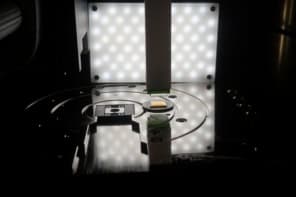
Mobile phones that get signal even in the remotest parts of the world could soon be a reality if a technology being developed by researchers in the US and UK gets off the ground. John Singleton of the Los Alamos National Laboratory in New Mexico and colleagues say that their “polarization synchrotron”, which they claim mimics the distinctive emission of pulsars, will enable extremely long-range or low-power radio communication.
Singleton’s team built and tested a proof-of-principle version of the device some five years ago. It consisted of a 2 m–long arc of dielectric with a series of electrodes embedded along its length. By applying a sinusoidally varying voltage across each electrode, but offsetting the phase of this voltage very slightly between neighbouring electrodes, they were able to produce a changing pattern of polarization along the dielectric that they say travelled faster than the speed of light (noting that no material object actually exceeds light speed).
Inspired by the Crab pulsar
They were inspired to do so by the work of team member Houshang Ardavan of Cambridge University, who had previously calculated that it was superluminal charge patterns that are responsible for the way in which pulsars — rapidly spinning neutron stars — generate their beams of radio waves that are visible on Earth as pulses. According to Ardavan, the electromagnetic radiation given off by the rotating charge pattern piles up into a tightly focused beam and this beam swings round like that of a lighthouse, a theory that the group says is backed up by recent observations of the Crab pulsar (Mon. Not. R. Astron. Soc. 388 873).
Singleton’s team believes that its polarization synchrotron also produces a tightly focused beam of radio waves in this way, and that the intensity of this radiation falls off as 1/r, rather than the 1/r2 of normal spherically decaying radiation. The group backed up this claim by measuring the output of the device over 3 km of airfield and is now putting the finishing touches to two much smaller, laptop-sized versions that they hope will demonstrate its commercial viability. The first of these, which they say should be finished early next year, will be circular, while the second, planned for later in the year, will be straight.
Patents pending
The group claims that the devices will allow spacecraft to transmit low-powered signals to Earth, or allow mobile phones to communicate directly with satellites, rather than having to rely on base stations. Singleton and colleagues have filed patents on various aspects of the technology and are talking with several interested potential sponsors. However, John Hannay, a theoretical physicist at Bristol University, told physicsworld.com that the group should first test its technology over at least several tens of kilometres.



